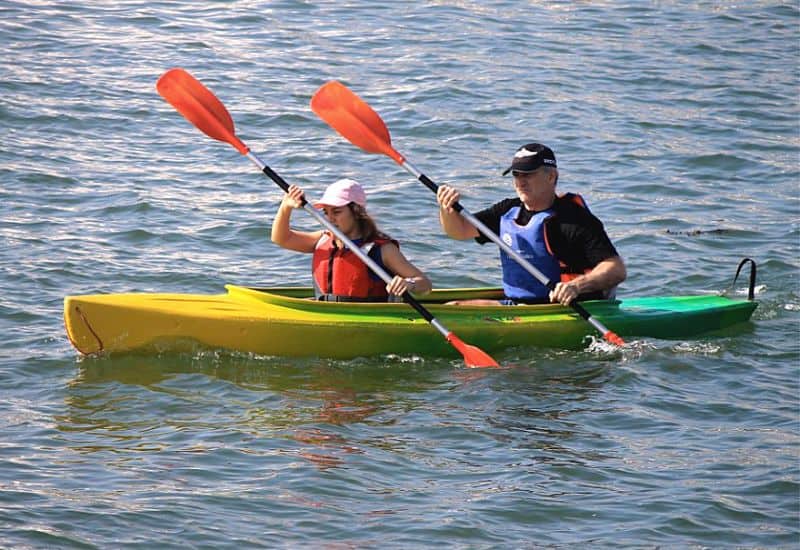While most people are familiar with kayaking, they may not be as familiar with tandem kayaking.
So in this blog post, we provide a full explanation of what tandem kayaking is.
Plus we answer some of the most common questions about tandem kayaking.
What is Tandem Kayaking?
Tandem kayaking is a type of kayaking, where two people use the same kayak to paddle and maneuver the kayak together.
Making tandem kayaking a two-person sport, as opposed to kayaking, which is typically a solo sport.
What’s the Difference Between a Kayak and a Tandem Kayak?
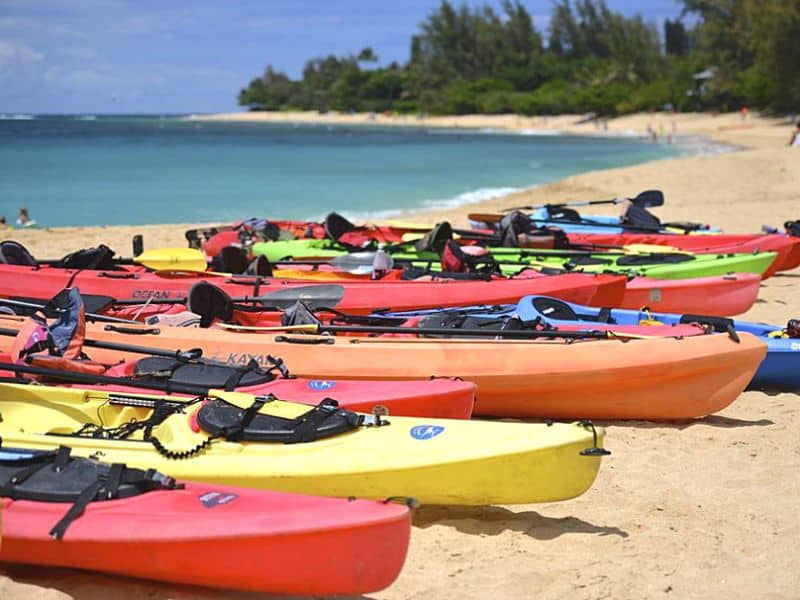
The most obvious difference between a kayak and a tandem kayak is that tandem kayaks are designed to hold two people, while a solo kayak is designed to hold just one.
But that’s not the only difference between a solo kayak and a double kayak.
As tandem kayaks also tend to be longer and wider compared to solo kayaks as well.
As most tandem kayaks are between 10 to 14 feet long and 34 to 38 inches wide.
While most solo recreational kayaks are between 6 to 10 feet long and 25 to 32 inches wide.
And because of this larger size and wider width, tandem kayaks tend to be much heavier compared to solo kayaks.
As most tandem kayaks weigh between 50 and 75 pounds, while most single kayaks weigh between 25 and 45 pounds.
The last major difference between tandem and solo kayaks is their weight capacities.
As tandem kayaks need to be able to handle much more weight compared to solo kayaks.
This is why most tandem kayaks have weight capacities from 500 to 600 pounds, while most single kayaks have weight capacities from 250 to 300 pounds.
How Do You Paddle a Tandem Kayak?
There are just a few simple tips and how-tos to keep in mind when paddling a tandem kayak.
That will allow you to get the most efficiency out of the double kayak and the maximum amount of fun.
Make Sure to Paddle in Unison
The first thing to keep in mind when paddling a tandem kayak is that you and your partner need to paddle in unison.
This means that both people need to start paddling at the same time, at the same speed, and with the same strokes.
Because if one person starts paddling too early or too late or out of sync with the other person, it can throw off the entire rhythm and make paddling less efficient.
So, it’s important to communicate with your partner and establish a paddling cadence that you can both stick to.
Plus paddling in unison also help to prevent your paddles from clashing together.
The Stronger and Heavier Paddler Should Always Sit in the Back
The next tip for paddling a double kayak is that the stronger and heavier paddler should always sit in the back, for several reasons.
First, it helps to properly distribute the weight inside the kayak.
As you want any extra weight to be at the stern or rear of the boat and not in the bow or front of the boat.
As kayaks that are front heavy with a lowered prow are more difficult to turn, less stable, and will slow the kayak considerably.
In addition, it’s also important to have the stronger paddler in the back, because this allows the weaker paddler in the front to set the pace.
Learn to Turn a Tandem Kayak the Right Way
To properly turn a tandem kayak the front paddler should take a forward sweep stroke on one side.
Which is a forward stroke that sweeps a wide arc out to the side of the boat.
While at the same time, the rear paddler takes a back sweep stroke on the opposite side of the boat.
Know What to Do if the Kayak Capsizes
If your kayak capsizes while you’re on the water, there are two main ways to get back into the kayak.
The first and more challenging way, which works best for sit-on-top kayaks is for one kayaker to climb back into the kayak in the water, while the other kayaker stays in the water to help stabilize the kayak.
This, however, can be very challenging and even more difficult if the tandem kayak is a sit-inside kayak.
As the kayak will more than likely be filled with water.
Which is why most people choose to swim the kayak back to shore and get back in from the shoreline.
Because of this, unless you’re confident in your ability to reenter a kayak from the water, it’s best to stay close to the shore and stick to calm waters that are protected from wind and waves.
Tandem Kayaking with Kids
When paddling a tandem kayak with kids, there are a few things to keep in mind.
Most important of course is that kids like adults should always be wearing a life jacket or personal flotation device when kayaking.
Also because of the reasons listed above, kids should always be sitting in the front of the kayak whether by themselves or between the legs of an adult.
Plus, this also allows the adult to maintain better control of the kayak and keep an eye on the child.
In addition, when kayaking with kids, it’s especially important to stick to calm water and stay close to the shore.
So in the unlikely event of a capsize, you can easily help the child swim to shore.
Which is Easier Single or Tandem Kayaks?
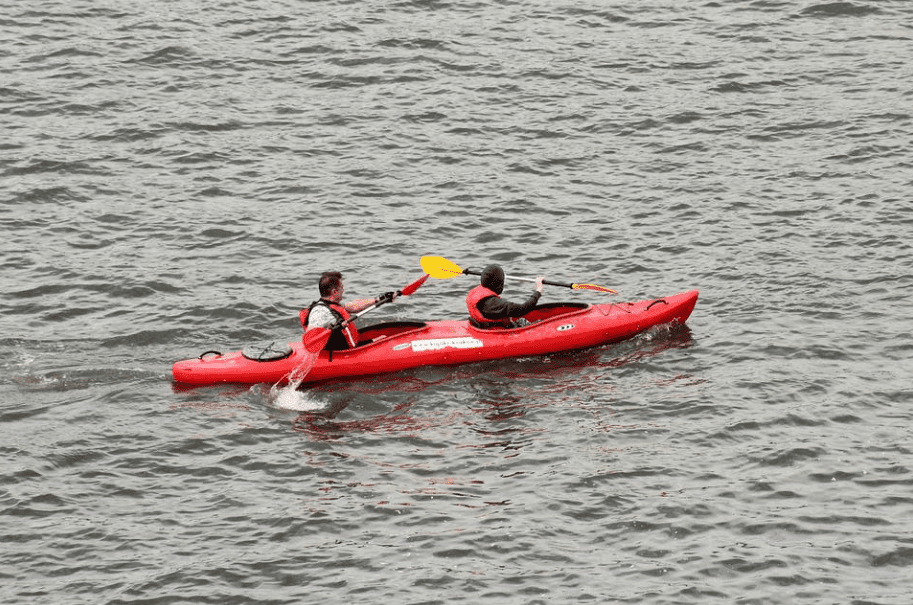
While tandem kayaks are more stable and easier to control than single kayaks, they also require more coordination between the two paddlers.
This is why many people find single kayaks to be easier to maneuver and control – especially for beginners.
However, tandem kayaks have their advantages too.
For instance, they can be faster and more efficient to paddle than a single kayak, since there are two people paddling.
Also, tandem kayaks can be more fun, since you have someone to chat with and share the experience with while you’re out on the water.
So while tandem kayaks may require more coordination, they offer a unique and fun experience that you can’t get with a single kayak.
Can One Person Paddle a Tandem Kayak?
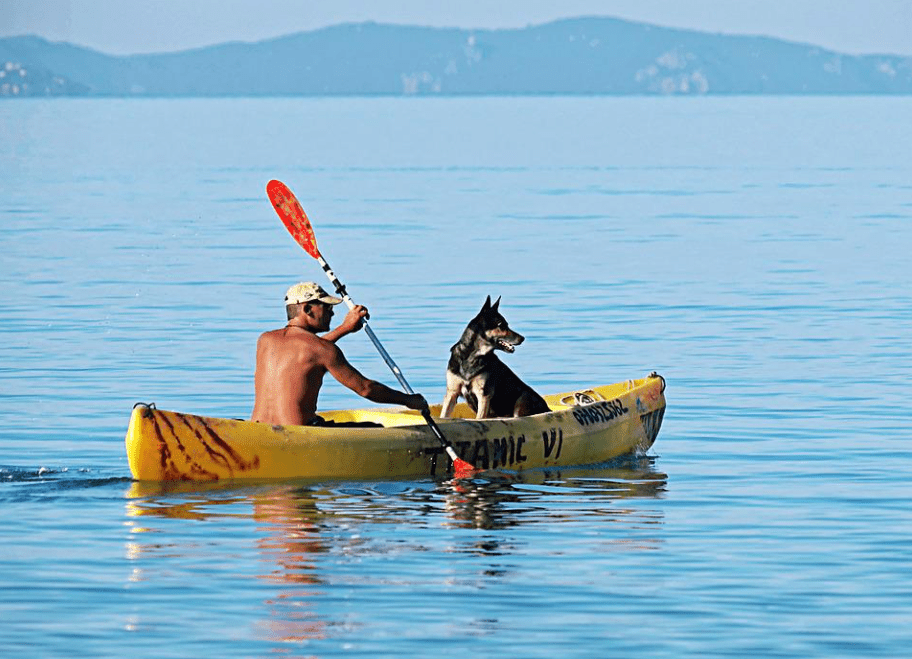
Yes, one person can paddle a tandem kayak, as long as they’re paddling from the back of the kayak, but it’s challenging and not recommended.
Because while you can technically paddle a tandem kayak by yourself, it’s not going to be easy.
As tandem kayaks are designed for two people and are much longer and wider than a single kayak.
Making them more difficult to control and maneuver with just one person– especially in windy or choppy conditions.
So unless you’re an experienced kayaker, it’s best to paddle a tandem kayak with someone else.
Plus, it’s more fun to paddle with someone else anyway!
How Do You Sit in a Tandem Kayak?
If the two paddlers using the tandem kayak are of similar weight and skill level, it really just comes down to personal preference on where they sit.
However, if one paddler is stronger or more skilled than the other, then the stronger and more skilled paddler should sit in the rear of the kayak.
As this allows the weaker or less skilled paddler to sit up front and set the pace.
In addition, if one paddler is heavier than the other, it’s best to have the heavier person sit in the back, as this helps to properly distribute the weight inside the kayak.
As you want any extra weight to be at the stern or rear of the kayak and not in the bow or the front.
As kayaks that are front-heavy are more difficult to turn, less stable, and slower.
Who Steers in a Two-Person Kayak?
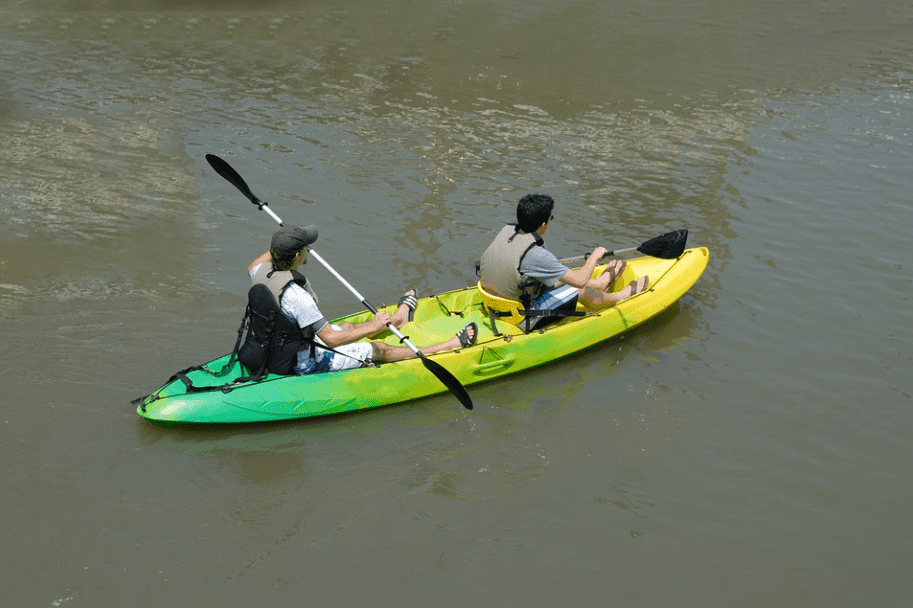
In a tandem kayak, both paddlers are responsible for keeping the kayak on course.
However, the person sitting in the back of the kayak is typically responsible for most of the steering, while in motion.
As they have a better view of where the kayak is going and can more easily direct it using their paddle strokes.
For more aggressive turning though, especially while stopped, both the front and rear paddler can steer the kayak, by paddling in the opposite direction.
Which will cause the kayak to spin in a circle.
Are all Tandem Kayaks Sit-on-Top?
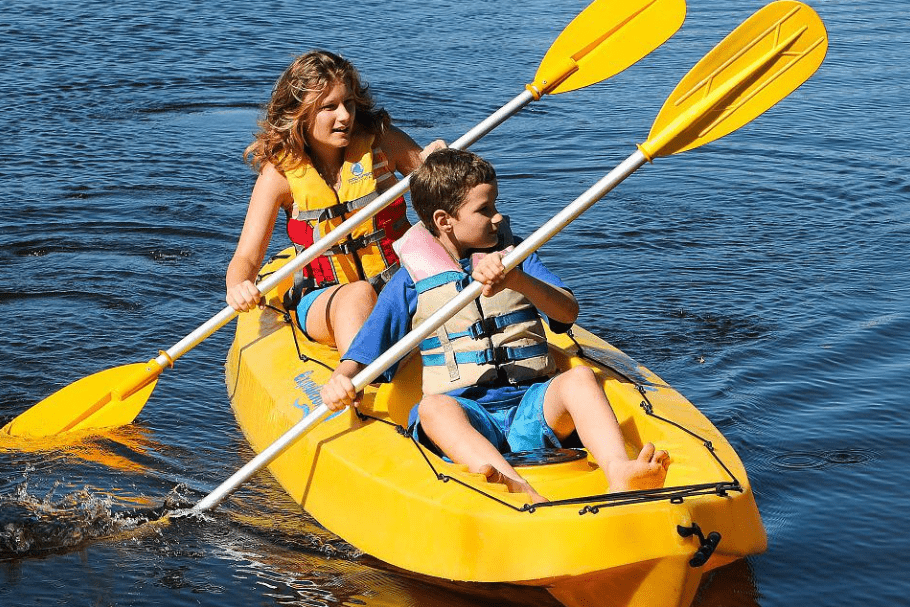
Not all tandem kayaks are sit-on-top.
As tandem kayaks can be both sit-on-top as well as sit-inside, depending on the type of kayaking they were designed for.
As sit-inside tandem kayaks have enclosed or partially enclosed cockpits that provide protection from the elements, making them ideal for longer trips.
While sit-on-top tandem kayaks are completely sealed and won’t take on water, which makes them much easier to get in and out of and ideal for rougher and choppier waters.
Is it Hard to Paddle a Tandem Kayak Solo?
Paddling a tandem kayak solo is possible but it’s challenging and here’s why.
Tandem kayaks are designed for two people and are much longer compared to single kayaks.
Because of this, they’re more difficult to control and maneuver when paddled by just one person.
Especially in windy or choppy conditions.
In addition, tandem kayaks are also wider than single kayaks, which can make them more difficult to keep on course when paddling solo.
So unless you’re an experienced kayaker, we recommend paddling a tandem kayak with someone else.
How Much are Tandem Kayaks?
Tandem kayaks tend to be more expensive compared to solo recreational kayaks and can vary in price based on the brand, type, and features of the kayak.
However, you can usually expect to pay between $500 and $1,000 for a decent quality tandem kayak.
For more information on how much kayaks and tandem kayaks cost, check out our article “How Much is a Kayak? (6 Types & 27 Examples)“.

